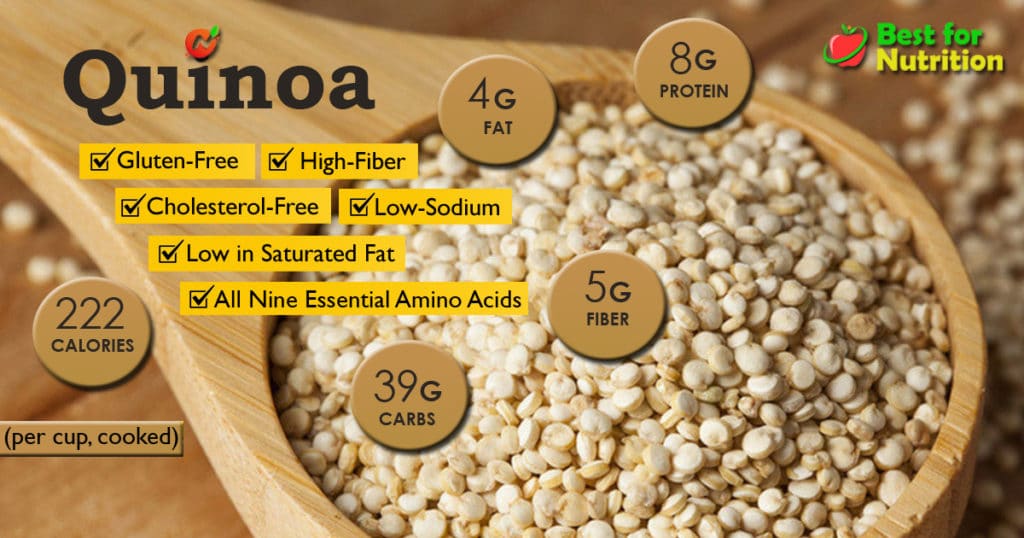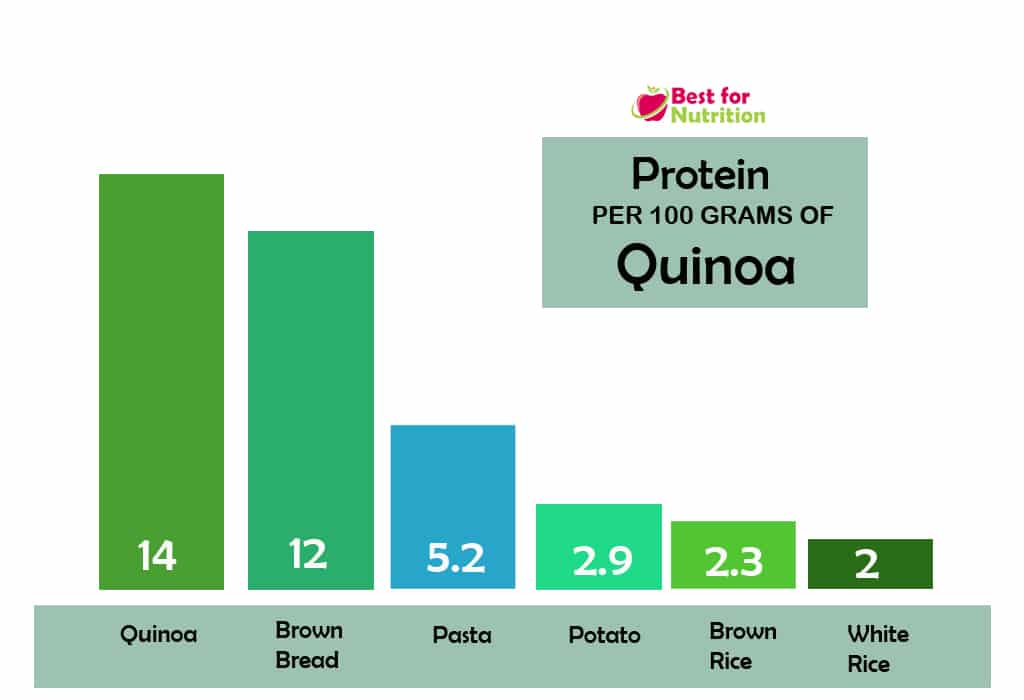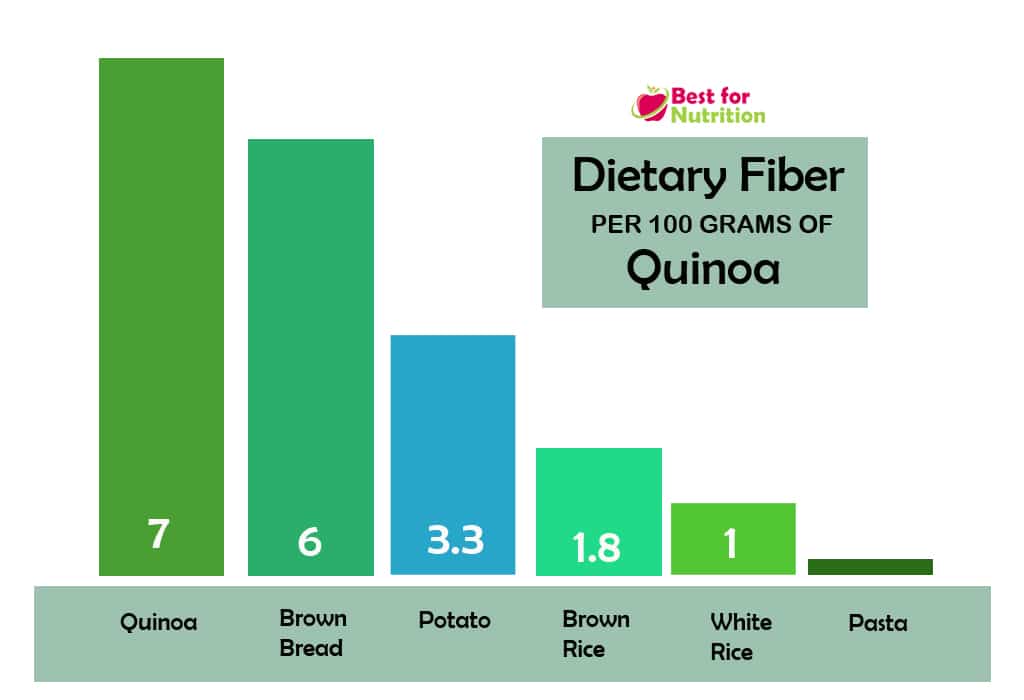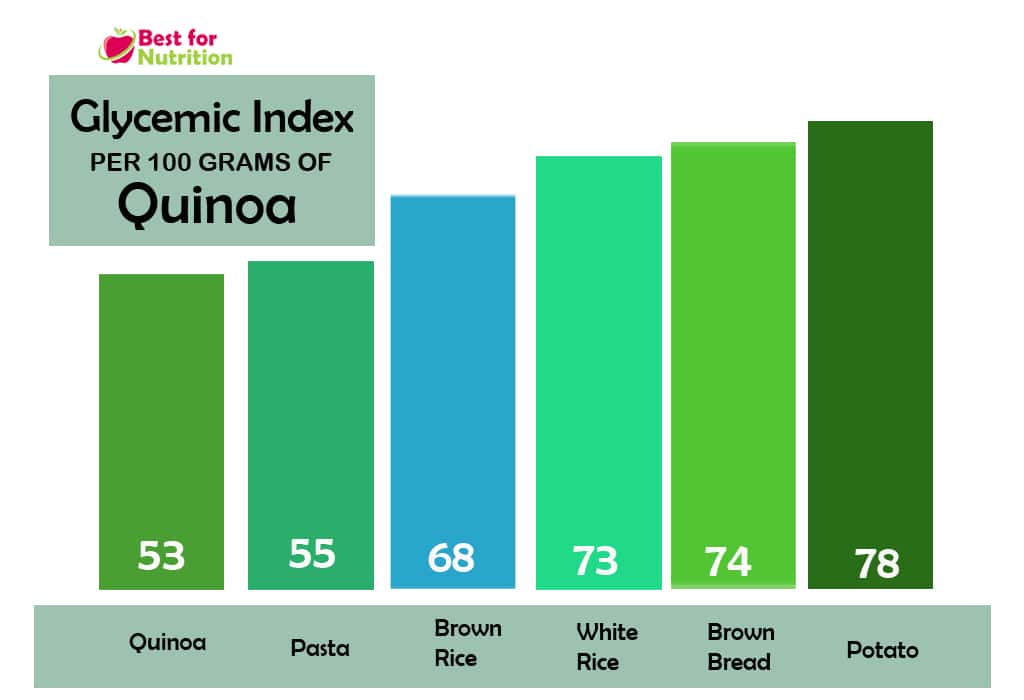Quinoa has been touted as a superfood or the super grain of the future and has fast earned a name for itself amongst the world’s healthiest foods.
Quinoa and its products are now found all over the world, especially in health stores and restaurants that emphasize clean eating.
However, the health benefits of quinoa are not known as widely.
What is Quinoa?
Quinoa (pronounced “KEEN-wah”) is a small edible seed that has been around for over 7000 years and first grown in the Andean region of South America. However, it is only recently that Quinoa has become popular amongst today’s health-conscious people and ever so rightly (1).
It is also being grown widely because it is genetically very diverse and it can be grown in different types of soils and has recently been found that it easily adapts to different climates and temperatures.
Although it is actually a seed, Quinoa is called a pseudo-grain because of its physical resemblance to a grain. It is rich in antioxidants, protein and a variety of vitamins and minerals. It can very easily be substituted for rice because of its many health benefits (2).
12 Impressive Health Benefits of Quinoa
Quinoa has a very unusual composition of nutrients and an exceptional balance between oil, protein, and fat. This makes it excellent for reducing the risk of various diseases (3).
It is Rich in Nutrients

Quinoa has a much higher nutritive value than any other cereal. It is an outstanding source of carbohydrates and fiber. It has come to be known as a complete food because of its protein content and unique composition of amino acids. Quinoa compares fairly well and in some ways above its grain counterparts (4).
Quinoa is also a good source of a wide variety of antioxidants and phytohormones. It also has polyphenols such as tannins, phenolic acids, and flavonoids which are known to have several physiological benefits (5).
Quinoa is a non-GMO food which means that it is not genetically modified. It is also gluten-free and usually grown naturally. This makes it a safe and healthy addition or replacement to our usual grains and cereals.
Here is the nutritional content in 1 cup of cooked quinoa (185 grams) (6):
- Calories: 222 kcal
- Carbohydrates: 39.4 grams
- Fiber: 5.2 grams
- Protein: 8.1 grams
- Fat: 3.6 grams
- Magnesium: 118 mg, 30% of the recommended daily intake (RDI)
- Phosphorus: 281 mg, 28% of the RDI
- Potassium: 318 mg, 9% of the RDI
- Manganese: 1.2 mg, 58% of of the RDI
- B-Vitamins: Over 10% of the RDI for vitamin B1, B2, and B6
Summary: Quinoa has a unique and rich nutrient profile making it a suitable choice for people wanting to switch to a healthier grain for health reasons.
Quinoa is Very High in Protein

Protein is extremely important to every cell in the body. The body needs it to repair and build cells. Amino acids in the protein join together in the form of long chains to perform these functions.
There are nine such amino acids that the body cannot do without. These essential amino acids are very important and cannot be made by the body on its own. Quinoa has all nine of them and is therefore called the complete protein.
Quinoa has higher amounts of these essential amino acids than most grains and legumes (7).
Generally, plant-based proteins are low in some essential amino acids, especially lysine. Lysine is an important amino acid that is responsible for the repair and growth of tissues. Quinoa has sufficient amounts of lysine and all other essential amino acids making it a complete protein.
Summary: Quinoa contains all nine essential amino acids making it a complete protein and very beneficial for the human body. It is the only grain that contains sufficient quantities of lysine.
Quinoa is Rich in Fiber

Quinoa is also known to have a high fiber content that helps slow the digestion process and keeps one feeling full longer. One cup of quinoa contains more than twice the amount of fiber in any other grain.
A 2005 study conducted in Italy, concluded that foods prepared with alternative cereals like quinoa, oats, and buckwheat kept the participants feeling satiated for a lot longer than their wheat and rice counterparts (8).
Another study conducted in Brazil in 2011, took 4 varieties of quinoa and found 10-16 grams of fiber in every 100 grams of quinoa. This is very high compared to many grains and seeds (9).
A large part of the fiber in quinoa is insoluble which may not have the same advantages as the soluble fiber. However, quinoa also has a substantial amount of soluble fibers. The fiber content in quinoa is known to relieve constipation, lower cholesterol and regulate blood sugar.
Summary: Quinoa has large amounts of fiber, much higher than any other grains. Adding it to your diet can help relieve constipation and also keep you feeling full longer.
A Healthy Choice For People With Gluten Intolerance

Another desirable benefit of quinoa is that it is gluten-free. This makes it ideal for people to add to their diets if they have any gluten intolerances. Even people with celiac disease, a severe gluten intolerance, are able to add quinoa to their diet safely.
Oftentimes, people on a gluten-free diet find it difficult to incorporate enough portions of essential nutrients through diet alone. Quinoa, with its nutrient-dense base, helps them reach their daily recommended doses of important minerals.
A 2009 study by Columbia University backs this up. Adding quinoa and other alternate grains as a replacement to wheat and rice, greatly increased the nutrient profile of a gluten-free diet (10).
In another 2014 study conducted in London, 19 celiac patients were given 50 grams of quinoa as part of their gluten-free diet for 6 weeks. This was well tolerated by all 19 patients; it did not exacerbate their condition and even lowered total cholesterol and triglycerides (11).
Added to those going gluten-free because of gluten intolerance is a large number of fitness and health enthusiasts who are choosing a gluten-free lifestyle for a healthier life. Even restaurants are now catering to them and several quinoa dishes can be seen on their menus.
Summary: Since quinoa is gluten-free and rich in its nutrient profile, it makes a great addition to a gluten-free diet for people with intolerances or even those choosing a gluten-free lifestyle for other reasons.
Quinoa has a Low Glycemic Index

People with diabetes need to manage their diet to regulate their blood sugar levels throughout the day. This means there should not be sharp or sudden rises in blood sugar levels throughout the day.
When choosing carbohydrates in a diabetic diet, it is recommended to choose grains that have the highest nutritional value and quinoa is an excellent choice.
Quinoa is considered to have a low glycemic index which means that it will not cause a sudden spike in your blood sugar on consumption. This is because of the fiber and protein content in quinoa which slows down the digestion process.
It was shown in a human-based study that consuming quinoa instead of gluten-free bread and pasta, reduced blood sugar and insulin to some extent. More research needs to be done to firmly establish this relation (12).
A 2009 study conducted in Brazil evaluated 10 Peruvian Andean grains and the study indicated that the combination of pseudo-grains like quinoa and other legumes is helpful in managing type 2 diabetes and associated hypertension (13).
A Polish study conducted in 2010 among high fructose-fed rats indicated that adding quinoa seeds to their diet acted as a moderate protective agent against the ill-effects of the high fructose being consumed (14).
Quinoa, when soaked whole in water, secretes bioactive phytochemicals which can be used to make a food-grade mixture that may be useful for anti-diabetic purposes (15).
It should also be noted that quinoa has a high amount of carbohydrates and may not be helpful to add to a low carb diet.
Summary: Quinoa has a positive impact on diabetics who are trying to manage their blood sugar levels because of its low glycemic index.
Quinoa May Promote Weight Loss

Quinoa has become very popular within weight loss circles because of the numerous benefits people are finding by adding it to their diet. Quinoa has several characteristics that make it an appropriate tool for weight loss quests.
Quinoa is calorie-dense which means it is filling and curtails hunger for a longer period of time. The fiber content in quinoa and its low glycemic index also makes it a good choice to be able to eat fewer calories and feel full. It is significantly high in protein which is known to reduce appetite and also improve metabolism (16, 17, 18).
Summary: Quinoa has several properties that aid weight loss. It has fiber, a low glycemic index and it is a calorie-dense food, all of which has been known to benefit anyone trying to lose weight and get healthy.
High in Important Minerals Like Iron & Magnesium
A standard diet consumed by an average person doesn’t seem to be giving them all the essential nutrients that they need. This is especially true of trace nutrients like iron, sulfur, zinc, magnesium, etc. that perform certain important biochemical functions. Iron deficiency is particularly a huge problem among women.
Quinoa is high in iron, zinc, magnesium, and potassium. It is especially high in magnesium where one cup of cooked quinoa gives you 30% of the recommended daily intake.
However, it is important to keep in mind that quinoa also contains a substance called phytic acid which is known to cause a negative effect on mineral absorption. But there’s a workaround. It has been found that soaking or sprouting the quinoa seeds before cooking lowers the phytic acid content and makes the absorption of these minerals more viable (19, 20).
People prone to kidney stones may need to be careful because of the oxalate content in quinoa. It has been shown that oxalates interfere with the absorption of some minerals and may bind with calcium to form stones in some individuals. It is important to note that most people do not face this problem with oxalate (21).
Summary: Quinoa contains substantial amounts of iron and magnesium and other minerals. It also had phytic acid which sometimes inhibits the absorption of these minerals. This can be overcome by soaking quinoa before cooking which will reduce the phytic acid drastically.
Quinoa is Rich in Antioxidants
For the proper physiological functioning of the human body, there needs to be a balance between the free radicals and antioxidants present in the body. If the number of free radicals begins to increase, the body goes into a state called oxidative stress which can cause a number of diseases (22).
Quinoa has a very high antioxidant content and hence is able to effectively neutralize the free radicals and slow down aging.
A 2009 study conducted in Sao Paulo, Brazil, compared antioxidant content in five types of cereals, three pseudocereals, and two legumes and found that quinoa has the highest antioxidant levels compared to all others (23).
It is also important to make note that it is best to sprout the quinoa before consumption because it intensifies the antioxidant content greatly (24).
Summary: Quinoa is known to have high antioxidant content which is helpful to prevent several diseases and fight the aging process. Sprouting the quinoa has also shown to increase the antioxidant content.
Quinoa Has Anti Inflammatory Properties
There is still a lot of research going on about the long term implications of chronic inflammation in the human body. There is evidence to suggest that a diet with anti-inflammatory foods is helpful to manage symptoms of inflammation.
Quinoa and other similar grains are known to reduce inflammation and its dangerous effects. This is because of certain trace nutrients present in quinoa which are very beneficial to health. Quinoa is exceptionally high in flavonoids and flavones which are plant antioxidants that have many health benefits including protection against inflammation (25, 26).
Quinoa is particularly high in two flavonols – kaempferol and quercetin. Not only have both these important molecules shown anti-inflammatory effects but also an antidepressant, and anti-cancer in animal studies (27, 28, 29, 30).
Since quinoa can easily replace a grain from the usual diet, adding it can have many benefits that go beyond just the vitamins and minerals that it has to offer.
Summary: Quinoa has several trace minerals in large quantities that have been proven to have anti-inflammatory properties.
Quinoa May Improve Heart Health
The high fiber content in quinoa is seen to aid the lowering of cholesterol levels. Bile, which is used in the digestion process, is formed in the liver partly by extracting cholesterol from the blood. Since fiber aids the digestion process and makes it more efficient, it brings down the LDL levels in the blood, which is the bad cholesterol.
Current Developments in Nutrition published a study in 2017, investigated the effects of different doses of quinoa (25 and 50 grams a day) in overweight and obese participants. They were given these doses of quinoa over a period of 12 weeks and they saw significant improvement in their triglyceride levels (31).
High levels of triglycerides are known to be associated with a risk of cardiovascular diseases because there is more fat circulating through the body. Another study performed on high fructose-fed rats showed a significant improvement in the LDL levels (57%) when they were given quinoa (32).
Quinoa also contains significant amounts of oleic acids, omega-3 fatty acids, and alpha-linolenic acids. In fact, the fatty acids in quinoa seem to hold up even after boiling and steaming whereas many foods lose their fatty acids when oxidized (33).
Summary: Quinoa has shown significant benefits for heart health by lowering cholesterol and triglyceride levels. Quinoa also has good quality monounsaturated fat which is good for the heart.
High In Magnesium Quinoa May Improve Bone Health
The benefits that come from quinoa for bone health is greatly due to its high magnesium content. Magnesium is crucial for the synthesis of glutathione which is an important antioxidant produced by the body and it protects the bones against several diseases by reducing oxidative stress.
Also, our bones need magnesium to absorb calcium making it vital for bone growth (34). A study showed that a particular compound in quinoa called daidzein inhibited bone loss in some mice (35).
Other minerals like zinc, copper, and manganese that are present in quinoa play a role in protecting bones.
Summary: Quinoa is helpful in protecting bone health because of its high mineral content.
Very Versatile Grain – Easy to Incorporate Into Your Diet
Quinoa is very easy to prepare and versatile because of the many ways it can be incorporated into the diet. Because of its similarity to staples like rice, it can be easily swapped with any other grain and even rice in any recipe.
This means you can add quinoa to a salad, soup, porridge, tacos, stuffed peppers, the list is endless.
Even when it comes to the cooking time it is far less than many of its grain counterparts because of its small size. It cooks in under 15 minutes. Quinoa goes well in all sorts of dishes – hot pot meals, cold salads and even in burgers. It has a slightly nutty flavor and you can get creative with its use by adding to smoothies or making homemade health bars.
Summary: Quinoa is very easy to add to any type of diet because of its neutral flavor and minimal cooking time. It is also easy to add it in different forms which makes it very versatile.
Types of Quinoa
There are almost 120 varieties of quinoa but broadly, they can be classified as red, white and black quinoa. These are the most widely available types commercially. White quinoa cooks the quickest and is the most widely available in stores. It also happens to have a milder flavor.
Red and black quinoa, on the other hand, has a slightly more earthy flavor. Chefs prefer to use the red quinoa in most dishes because it tends to hold shape better even after cooking. The black quinoa takes the longest to cook. Nutritionally, there is subtle variation between the types of quinoa (36).
How to Include Quinoa In Your Diet
Quinoa has a slightly bitter coating called saponin. These are chemicals mainly to protect plants from diseases that can come from fungi, bacteria, and viruses. These saponins should be thoroughly washed before cooking the quinoa. Some packaged quinoa come pre-washed.
Washing or soaking the quinoa seeds reduces the saponins considerably. Sprouting quinoa also helps with this. The sprouting process can be sped up by soaking the quinoa seeds in water for 24 hours. A small portion of residual saponins is not harmful to a person with normal metabolism.
Once the quinoa is washed and ready, it is easy to cook it because it takes less than 15 minutes to puff up in size and become fluffy, ready for consumption. One cup of raw quinoa can yield up to three cups of cooked quinoa. Quinoa can be eaten like rice or couscous with a side dish. Alternatively, it can be used in salads, soups, stuffed vegetables, and even smoothies.
Quinoa can also be made into a flour to be used in bread for healthier, gluten-free options. Quinoa is also a perfect replacement for pasta in salads and rice in sushi.
Summary: Quinoa needs to be washed well before cooking to get rid of the bitter-tasting saponins. It is extremely versatile as a grain and can be used in many ways from soups, salads to just being a replacement to rice.
The Final Note
Quinoa, the ancient Andean grain, is rightly called a superfood because of its rich fiber and protein content. It is also a rich source of antioxidants and several trace nutrients that are essential to the human body. Adding quinoa to your diet is extremely beneficial as it helps reduce inflammation and even helps to manage blood sugar levels.
It is also gluten-free, so it makes a great substitute in a gluten-free diet. It is even known to help with weight loss. Quinoa has a great impact on heart health because it brings down cholesterol and triglyceride levels. It also has a positive effect on overall bone health and growth.
Quinoa is easy and quick to cook and very versatile, which makes it a suitable addition to several dishes. Quinoa is one of the most nutritious grains which also happens to be very delicious with its mild nutty flavor.